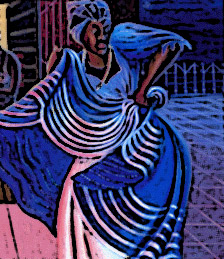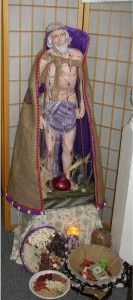
A depiction of the Orisha Yemayá dancing.
Who exactly are the Orishas? Why do some people call them The Saints? Why do some folks point to a statue of Saint Barbara and call it Shangó? This is one of the many confusing things for newcomers to Santeria and it is the drawback of syncretism.
Long before the Lucumí people were brought to Cuba in the slave trade, Christian missionaries were already present in Subsaharan Africa doing their best to convert people to their religions. One of the ways missionaries bridged the cultural gap between traditional African religion and Catholicism was to point out similarities in their beliefs. This made conversion away from traditional religion and into Catholicism much smoother and often a very natural transition for the Yoruba people. So long before the Lucumí ended up in Cuba they were already drawing parallels between Catholic saints and the Orishas. But to get to the bottom of it, you need to understand how we view God and the Orishas in Santeria.
In Santeria we call God Olodumare, Olorun or Olofi (three names for one force). Olodumare is God the creator. Olorun is God the owner of heaven (sometimes perceived as the Sun). Olofi is seen as God the ruler over the earth. But these three names for God are all seen as one generative force that created all of the universe.
Olodumare created everything: heaven, earth, the animals, and breathed life into humanity. Olodumare is beyond any gender labels but I personally prefer to refer to Olodumare as the divine feminine generative force or “She”. According to our patakis (legends), Olodumare created everything, created the Orishas (Her oldest children) and assigned a portion of Her ashé (power, life force) to each of the Orishas. She gave them dominion over nature and mankind. Then Olodumare departed, rather annoyed with humanity and our annoying tendencies, and left the Orishas to tend to our affairs. For this reason, Olodumare is perceived as a distant and relatively uninvolved creator goddess. While we do praise Olodumare with every ritual invocation, we actually interact on a daily basis with the Orishas.
Depending on how you break down the word Orisha, it either means “selected head” (as in God’s selected ones to rule) or “streams of consciousness” (as in the currents of ashé that emanate from Olodumare). The Orishas have a vested interest in mankind. They intercede on our behalf when we pray to them, engage them with ebó (offerings) and they change our destinies for the better. The Orishas can also put obstacles in our way to test our character or to see if we will conduct ourselves with integrity, humility and respect. The Orishas are not gods and goddesses, but they are Olodumare’s divine chosen children who watch over us. In many ways it was natural for Christian missionaries to compare the Orishas to Saints. Saints are not God but they are divine messengers who intercede on the behalf of humanity when we pray. The parallels were clearly there and missionaries took advantage of that to begin drawing Lucumí initiates into Catholic worship.

Saint Lazarus statue with offerings to the Orisha Babalú Ayé(hand made cape, baskets panuelos and eleke by Rosita Eleggua)
When the slaves were taken to the Americas, the practice of syncretizing saints with Orishas was already occurring, and it afforded the slaves an opportunity to continue practicing their traditional Lucumí beliefs without their slave masters getting too suspicious. The practice of calling the Orishas saints became firmly entrenched in the religious practices of Santeria. It is so prevalent that many practitioners will refer to the Orishas by their syncretized saint names more often than their Lucumí names. For example, it is much more common for a practitioner of Santeria to call Babalú Ayé by the name Saint Lazarus. Other Orishas succumbed to the same fate:
- Changó – Saint Barbara
- Yemayá – Our Lady of Regla
- Oshún – Our Lady of Charity of Cobre
- Elegguá – Saint Anthony or the Holy Infant of Atocha
- Ogún – Saint Peter
- Obatalá – Our Lady of Mercy
- Aggayú – Saint Christopher
There are many other examples of syncretism but these are the most common ones. So for the common folk, a loud clap of thunder evoked fear of Changó, but they would all proclaim “Hail Saint Barbara!” Syncretism even resulted in the Lucumí people holding sacred drum ceremonies (Añá – Tambor de Fundamento) on Catholic saint feast days; parading through the streets while playing African batá drums and carrying saint statues.
But now that the colonial times are over, people are realizing the impact that Catholicism and slavery had on Santeria. More people are moving away from syncretism toward a more traditionally African way of worship. As anyone who has been initiated in La Regla Lucumí can tell you, the Catholic façade quickly drops away once you enter our sacred room of worship. More practitioners of Santeria are now praying exclusively in Lucumí instead of in Spanish. More are pushing aside saint statues and preferring traditional beadwork, cowrie shell ornamentation and African ways of decorating their shrines. There is even a movement in Santeria to do away with the word Santeria itself and use the proper term Lucumí (Lukumí) which comes from the African saying “my friends” or the religion of my people.
In the strictest sense, the Orishas are not saints, they are Olodumare’s eldest children sent to intercede on our behalf and help us achieve our greatest destiny. They are extensions of Olodumare’s power, streams of her ashé that we can tap into for personal development and spiritual evolution. They speak Lucumí (Lukumí) and don’t respond to prayers to Jehovah. They dance with us, speak to us and encourage us to live life fully and develop good character. They are the pillars of our faith and the Santeria Church of the Orishas is dedicated to raising awareness about them.

 Pagan Blog Project
Pagan Blog Project
Follow Us!